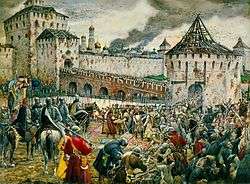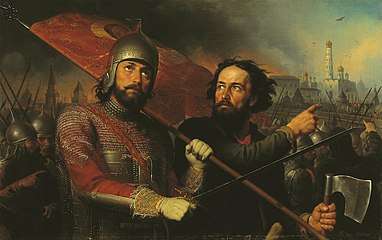Polish–Lithuanian occupation of Moscow
The Polish-Lithuanian occupation of Moscow was a two year period (from autumn 1610 to autumn 1612) during the Russian–Polish War when the Moscow Kremlin was occupied by a Polish–Lithuanian garrison. This took place during the Time of Troubles, with the force in question under the command of Stanisław Żółkiewski and assisted by Russian boyars led by Mikhail Saltykov.
From March 1611 to autumn 1612, the Cossacks of Prince Dmitry Trubetskoy besieged Moscow and the Polish-Lithuanian forces there. The city was finally liberated by the Second People's Militia and the date of the capture of Kitay–Gorod (November 1 in the Gregorian style, October 22 in the Julian calendar) is celebrated symbolically in modern Russia as a Day of National Unity[1] on November 4, alongside festivities in honor of the Kazan Icon of Mother of God.
Żółkiewski in Moscow
.jpg)
After the tsarist troops were defeated at Klushino and the Seven Boyars agreed to elevate the prince Vladislav to the Russian throne, to maintain order in the capital until the arrival of the new head of state in October–November 1610, the Polish–Lithuanian troops of Stanislav Żółkiewski entered Moscow without a fight. From the beginning of August, Żółkiewskicamped on the Khoroshevsky Meadows and the Khodynsky Field. He entered the city under the pressure from the king, although he himself was against the occupation of the Russian capital.[2]
At the end of 1610 in Moscow and the Novodevichy Convent, about 6,000 soldiers of armored and hussar banners, 800 infantrymen of a foreign order, 400 hayduks were stationed in Moscow and the Novodevichy Convent – only four regiments led by Alexander Gonsevsky, Martin Kazanovsky, Alexander Zborovsky and Ludwig Weicher. For each soldier, there were three civilians from among the "Tushinites" who had joined them on the way to Moscow, servants and waitresses.[2]
Żółkiewski placed the soldiers in Moscow so that in the event of an attack they could come to each other's aid or retreat to the Kremlin. A significant part of the garrison was located west of the Kremlin wall near the Neglinnaya River. To maintain order, a tribunal was established in which the Russian side was represented by Grigory Romodanovsky and Ivan Streshnev, and the Polish–Lithuanian side – by Alexander Korychinsky and Lieutenant Malynsky.[2]
When Żółkiewski went to Smolensk in November for a meeting with Sigismund III, he took his regiments with him. Several units were left at the Novodevichy Convent to control the roads to Mozhaysk and Volokolamsk. The rest of the hetman placed closer to the besieged Smolensk – in Vereya and Mozhaysk.
Siege of Moscow by the Cossacks
In March 1611, in connection with the formation of the First People's Militia, the commander of the Polish–Lithuanian garrison, Gonsevsky, provoked street battles, during which most of Moscow burned down. Having broken the resistance of the townspeople in advance, Gonsevsky hoped to minimize support for the First Militia.
In April and early May, the militias stormed the ramparts of the Zemlyanoy City and the walls of the White City, liberating most of the territory of Moscow (more than 95%), after which they locked the invaders behind the Kitay–Gorod and Kremlin Walls. The Cossacks of Prince Dmitry Trubetskoy actually took the Kremlin garrison under siege.
Together with the Poles, members of the Semiboyarshchina sat in the besieged Kremlin, as well as the future Tsar Mikhail Fedorovich Romanov with his mother.[3]
Hunger and cannibalism

Provisions for the garrison were collected in the Moscow region by the regiment of Jan Peter Sapega. To feed the Polish–Lithuanian army were allocated "stations" (areas) northeast of Moscow. According to the testimony of the memoirist Samuil Maskevich, "what anyone liked, and whether the greatest boyar's wife or daughter, they took them by force".[4] After the death of Sapieha in September 1611, Jan Karol Chodkiewicz, the great Lithuanian hetman, took over the difficult task of collecting food.
The entire first half of 1612 was unusually cold. Not receiving salaries, many of the garrison's soldiers formed a confederation and left the Russian capital. Famine began in the city. Speculators from the Moscow region sold bread in the city at 30 times the price.
At the end of 1611, carts with provisions collected by Samuil Koretsky reached the Kremlin. In January 1612, Budzila's regiment was able to break through to Moscow. He brought up food supplies, which temporarily eased the food situation. The Hungarian infantrymen of Felix Nevyarovsky, who later arrived in time, did not bring food and their presence only accelerated the return of the lack of food. On July 25, Yakub Bobovsky brought several carts of grain, but it was a drop in the sea.
Avraamy Palitsyn claims that after their entry into the Kremlin, Trubetskoy's Cossacks "having acquired a lot of vanities and half of human flesh are salty and under the slings there is a lot of human corpse".[5]
Autumn 1612

Seeing the uselessness of resistance, the Polish–Lithuanian formations began to leave the city. The most efficient regiment of Zborovsky went to Smolensk in early June 1612. Until the end of the summer, Gonsevsky followed him with all the veterans of the Klushino Battle.[6] Together with them, the retreating took away the remnants of the Kremlin treasury. Nikolai Strus was left at the head of the garrison of Gonsevsky.
In early autumn, Khodkevich returned from a campaign in the Upper Volga lands with 400 carts of provisions. During the bloody battles on September 1–3, 1612, he approached the besieged Kremlin by 1800 meters, but having lost fifteen hundred soldiers in 2 days of fighting, he was forced to retreat. After that, the fate of the besieged was sealed.
Trubetskoy's Cossacks at the beginning of November[7] established control over Kitay–Gorod, after which Strus opened negotiations on the terms of surrender. The Kremlin garrison capitulated on November 7. Although they promised to "leave the defeated in health and have respect", after the surrender of the Kremlin, a massacre of its defenders took place: "The Cossacks beat the whole regiment, leaving a few".[8]
Fate of the prisoners

Before the Truce of Deulino of 1619 and the exchange of prisoners that followed, the Poles and Litvins captured in the Kremlin were settled in Yaroslavl, Balakhna, Nizhny Novgorod and other Upper Volga cities. The prisoners in Galich and Unzha were completely exterminated. In Nizhny Novgorod, the mother of Prince Pozharsky stood up for Budzila with her comrades, after which they were placed "in a dungeon in which they had been sitting for nineteen weeks, very dark, thin and stinking".[9]
See also
References
- See the translation of dates from the Julian calendar
- Tomas Bohun. History of the Polish Garrison in Moscow
- Alexey Zakharevich. Russian Tsars. Phoenix, 2009. Page 127
- Maskiewicz S. Dyjariusz Samuela Maskiewicza: Początek swój bierze od roku 1594 w lata po sobie idące // Moskwa w rękach Polaków: Pamiętniki dowódców i oficerów garnizonu polskiego w Moskwie w latach 1610—1612. — Liszki, 1995. — S. 175—176
- The Legend of Avraamy Palitsyn – Moscow: Publishing House of the Academy of Sciences of the Soviet Union, 1955 – Page 228
- Ruslan Skrynnikov. On Guard of the Moscow Borders – Moscow, 1986
- Various sources date this event on November 1st, 2nd, 3rd or 4th
- New Chronicler // Complete Collection of Russian Chronicles – Volume 14 – Moscow, 1965 – Page 127
- Budziłło J. Wojna moskiewska wzniecona i prowadzona z okazji fałszywych Dymitrów od 1603 do 1612 r. — Wrocław, 1995. — S. 136—138, 167
Sources
- Boris Florea. Polish–Lithuanian Intervention in Russia and Russian Society / Boris Florea; Russian Academy of Sciences, Institute of Slavic Studies – Moscow: Indrik, 2005 (Production and Printing Enterprise Printing House Nauka) – 415 Pages – ISBN 5-85759-303-4